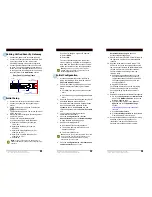
ZyWALL 10 Internet Security Gateway
What Is a Firewall?
13-9
If an initiation packet originates on the LAN, this means that someone is trying to make a connection from
the LAN to the Internet. Assuming that this is an acceptable part of the security policy (as is the case with the
default policy), the connection will be allowed through. A cache entry is added which includes connection
information such as IP addresses, TCP ports, sequence numbers, etc.
When any subsequent packet hits the box (from the Internet or from the LAN), its connection information is
extracted and checked against the cache. A packet is only allowed to pass through if it corresponds to a valid
connection (that is, if it is a response to a connection which originated on the LAN).
13.4.4 UDP/ICMP Security
UDP and ICMP do not themselves contain any connection information (such as sequence numbers).
However, at the very minimum, they contain an IP address pair (source and destination). UDP also contains
port pairs, and ICMP has type and code information. All of these data can be analyzed in order to build
"virtual connections" in the cache.
For instance, any UDP packet that originates on the LAN will create a cache entry. Its IP address and port
pairs will be stored. For a short period of time, UDP packets from the WAN that have matching IP and UDP
information will be allowed back in through the firewall.
A similar situation exists for ICMP, except that the ZyWALL is even more restrictive. Specifically, only
outgoing echoes will allow incoming echo replies, outgoing address mask requests will allow incoming
address mask replies, and outgoing timestamp requests will allow incoming timestamp replies. No other
ICMP packets are allowed in through the firewall, simply because they are too dangerous and contain too
little tracking information. For instance, ICMP redirect packets are never allowed in, since they could be used
to reroute traffic through attacking machines.
13.4.5 Upper Layer Protocols
Some higher layer protocols (such as FTP and RealAudio) utilize multiple network connections
simultaneously. In general terms, they usually have a "control connection" which is used for sending
commands between endpoints, and then "data connections" which are used for transmitting bulk information.
Consider the FTP protocol. A user on the LAN opens a control connection to a server on the Internet and
requests a file. At this point, the remote server will open a data connection from the Internet. For FTP to
work properly, this connection must be allowed to pass through even though a connection from the Internet
would normally be rejected.
In order to achieve this, the ZyWALL inspects the application-level FTP data. Specifically, it searches for
outgoing "PORT" commands, and when it sees these, it adds a cache entry for the anticipated data
connection. This can be done safely, since the PORT command contains address and port information, which
can be used to uniquely identify the connection.
Any protocol that operates in this way must be supported on a case-by-case basis. You can use the ZyWALL
Web Configurator’s Custom Ports feature to do this.
13.5 Guidelines For Enhancing Security With Your Firewall
1.
Change the default password on the SMT and Web Configurator.
Содержание ZyWALL 10
Страница 1: ...ZyWALL 10 Internet Security Gateway User s Guide Version 3 20 November 2000...
Страница 6: ...ZyWALL 10 Internet Security Gateway vi CE Doc...
Страница 22: ......
Страница 26: ......
Страница 30: ......
Страница 73: ......
Страница 96: ......
Страница 138: ......
Страница 161: ......
Страница 169: ......
Страница 181: ......
Страница 195: ......
Страница 203: ......
Страница 222: ......
Страница 226: ......
















































